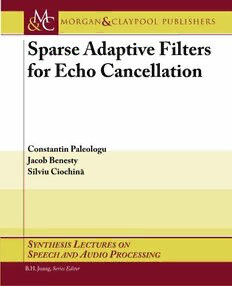
Sparse Adaptive Filters for Echo Cancellation PDF
Preview Sparse Adaptive Filters for Echo Cancellation
Sparse Adaptive Filters for Echo Cancellation Synthesis Lectures on Speech and Audio Processing Editor B.H.Juang,GeorgiaTech SparseAdaptiveFiltersforEchoCancellation ConstantinPaleologu,JacobBenesty,andSilviuCiochina˘ 2010 Multi-PitchEstimation MadsGræsbøllChristensenandAndreasJakobsson 2009 DiscriminativeLearningforSpeechRecognition:TheoryandPractice XiaodongHeandLiDeng 2008 LatentSemanticMapping:Principles&Applications JeromeR.Bellegarda 2007 DynamicSpeechModels:Theory,Algorithms,andApplications LiDeng 2006 ArticulationandIntelligibility JontB.Allen 2005 Copyright© 2010byMorgan&Claypool Allrightsreserved.Nopartofthispublicationmaybereproduced,storedinaretrievalsystem,ortransmittedin anyformorbyanymeans—electronic,mechanical,photocopy,recording,oranyotherexceptforbriefquotationsin printedreviews,withoutthepriorpermissionofthepublisher. SparseAdaptiveFiltersforEchoCancellation ConstantinPaleologu,JacobBenesty,andSilviuCiochina˘ www.morganclaypool.com ISBN:9781598293067 paperback ISBN:9781598293074 ebook DOI10.2200/S00289ED1V01Y201006SAP006 APublicationintheMorgan&ClaypoolPublishersseries SYNTHESISLECTURESONSPEECHANDAUDIOPROCESSING Lecture#6 SeriesEditor:B.H.Juang,GeorgiaTech SeriesISSN SynthesisLecturesonSpeechandAudioProcessing Print1932-121X Electronic1932-1678 Sparse Adaptive Filters for Echo Cancellation Constantin Paleologu UniversityPolitehnicaofBucharest,Bucharest,Romania Jacob Benesty INRS-EMT,UniversityofQuebec,Montreal,Canada Silviu Ciochina˘ UniversityPolitehnicaofBucharest,Bucharest,Romania SYNTHESISLECTURESONSPEECHANDAUDIOPROCESSING#6 M &C Morgan &cLaypool publishers ABSTRACT Adaptivefilterswithalargenumberofcoefficientsareusuallyinvolvedinbothnetworkandacoustic echocancellation.Consequently,itisimportanttoimprovetheconvergencerateandtrackingofthe conventionalalgorithmsusedfortheseapplications.Thiscanbeachievedbyexploitingthesparse- nesscharacteroftheechopaths.Identificationofsparseimpulseresponseswasaddressedmainlyin thelastdecadewiththedevelopmentoftheso-called“proportionate”-typealgorithms.Thegoalof this book is to present the most important sparse adaptive filters developed for echo cancellation. Besides a comprehensive review of the basic proportionate-type algorithms,we also present some of the latest developments in the field and propose some new solutions for further performance improvement,e.g.,variablestep-sizeversionsandnovelproportionate-typeaffineprojectionalgo- rithms.Anexperimentalstudyisalsoprovidedinordertocomparemanysparseadaptivefiltersin differentechocancellationscenarios. KEYWORDS network and acoustic echo cancellation, adaptive filters, sparseness, Wiener, LMS, ± NLMS,VSS-NLMS,PNLMS,IPNLMS,EG ,VSS-PNLMS,APA,PAPA vii Contents 1 Introduction.................................................................1 1.1 EchoCancellation..........................................................1 1.2 Double-TalkDetection......................................................3 1.3 SparseAdaptiveFilters......................................................4 1.4 Notation...................................................................5 2 SparsenessMeasures ......................................................... 7 2.1 VectorNorms..............................................................7 2.2 ExamplesofImpulseResponses..............................................9 2.3 SparsenessMeasureBasedonthe(cid:2)0 Norm....................................9 2.4 SparsenessMeasureBasedonthe(cid:2)1 and(cid:2)2 Norms...........................10 2.5 SparsenessMeasureBasedonthe(cid:2)1 and(cid:2)∞ Norms..........................11 2.6 SparsenessMeasureBasedonthe(cid:2)2 and(cid:2)∞ Norms..........................12 3 PerformanceMeasures ...................................................... 15 3.1 Mean-SquareError........................................................15 3.2 Echo-ReturnLossEnhancement ...........................................16 3.3 Misalignment.............................................................17 4 WienerandBasicAdaptiveFilters............................................19 4.1 WienerFilter .............................................................19 4.1.1 EfficientComputationoftheWiener-HopfEquations..................22 4.2 DeterministicAlgorithm...................................................24 4.3 StochasticAlgorithm......................................................28 4.4 VariableStep-SizeNLMSAlgorithm .......................................31 4.4.1 ConvergenceoftheMisalignment ....................................33 4.5 SignAlgorithms...........................................................34 viii 5 BasicProportionate-TypeNLMSAdaptiveFilters ............................37 5.1 GeneralDerivation........................................................37 5.2 TheProportionateNLMS(PNLMS)andPNLMS++Algorithms .............39 5.3 TheSignedRegressorPNLMSAlgorithm...................................40 5.4 TheImprovedPNLMS(IPNLMS)Algorithms..............................41 5.4.1 TheRegularIPNLMS...............................................42 5.4.2 TheIPNLMSwiththe(cid:2)0 Norm .....................................44 5.4.3 TheIPNLMSwithaNorm-LikeDiversityMeasure....................45 6 TheExponentiatedGradientAlgorithms.....................................47 6.1 CostFunction.............................................................47 6.2 TheEGAlgorithmforPositiveWeights.....................................48 ± 6.3 TheEG AlgorithmforPositiveandNegativeWeights ......................49 ± 6.4 LinkBetweenNLMSandEG Algorithms.................................51 ± 6.5 LinkBetweenIPNLMSandEG Algorithms...............................53 7 TheMu-LawPNLMSandOtherPNLMS-TypeAlgorithms ..................55 7.1 TheMu-LawPNLMSAlgorithms .........................................55 7.2 TheSparseness-ControlledPNLMSAlgorithms.............................59 7.3 ThePNLMSAlgorithmwithIndividualActivationFactors...................60 8 VariableStep-SizePNLMSAlgorithms ...................................... 65 8.1 ConsiderationsontheConvergenceoftheNLMSAlgorithm..................65 8.2 AVariableStep-SizePNLMSAlgorithm....................................70 9 ProportionateAffineProjectionAlgorithms...................................73 9.1 ClassicalDerivation .......................................................73 9.2 ANovelDerivation........................................................75 9.3 AVariableStep-SizeVersion...............................................79 10 ExperimentalStudy .........................................................87 10.1 ExperimentalConditions...................................................87 CONTENTS ix 10.2 IPNLMSVersusPNLMS..................................................88 10.3 MPNLMS,SC-PNLMS,andIAF-PNLMS.................................92 10.4 VSS-IPNLMS............................................................95 10.5 PAPAs...................................................................96 Bibliography...............................................................103 Index......................................................................111 Authors’Biographies.......................................................113
